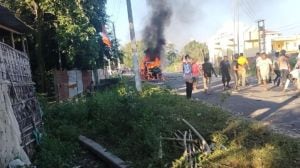A disaster waiting to be averted
As monsoon clouds loom large over Mumbai, memories of the deluge that crippled normal life in the city for three days in August last year fl...

As monsoon clouds loom large over Mumbai, memories of the deluge that crippled normal life in the city for three days in August last year flood the mind. Suburban train services collapsed, almost all arterial roads were flooded with waist-deep water, and thousands of office-goers were stranded for almost two days in their offices. Two days of constant heavy downpour claimed 15 lives and left 25 injured in instances of building collapses and electrocution.
The Brihanmumbai Municipal Corporation (BMC) and the Central and Western Railway blamed the “unforeseen forces of nature” and each other for the sorry situation. The state government, on its part, blamed both agencies for having failed to clean the drains, nallahs and other storm water outlets in the city.
Alarmed at the devastating effect of the downpour on August 22-23, 1997, Chief Minister Manohar Joshi called an emergency Cabinet meeting, attended by all the departments of the state government and the BMC to formulate a Disaster ManagementPlan (DMP) to avert such situations in future.
Though the 14-member committee, headed by the chief secretary and comprising the BMC and police commissioners, general managers of CR, WR, BEST and MSRTC, suburban and city collectors, and chief fire officer held a series of meetings throughout the year and prepared a comprehensive DMP for Mumbai, only time — and the rains this year — will prove its effectiveness.
“Though full implementation of the DMP will take some more time, concrete steps have been taken to see that the least possible damage takes place, and the effect of such eventualities is minimal on normal life,” said Johny Joseph, secretary to the Disaster Management, Relief and Rehabilitation Department of the state government.
“But unlike last year, we are much better prepared. The BMC will manage the disaster situation without the intervention of the state authorities, but depending on the magnitude of the disaster, the co-ordination mechanism will be monitored by the additional chiefsecretary to the Home department,” Joseph said.
The Disaster Management Action Plan (DMAP) provides for better co-ordination of various control rooms, departments of BMC, CR and WR, police and the state government. With over 40 lakh people commuting daily through BEST buses and suburban railways, any disruption of transport services leads to immediate and complete chaos. As a substantial working population is drawn to the city from Thane district and Navi Mumbai, any disruption of these services also affects the population there. The situation is worse at the terminal and transit hubs like CST, Churchgate, Dadar, Kurla and Thane. The DMAP, therefore, also involves the co-ordination mechanism of the Thane and Navi Mumbai municipal corporations and police.
“The aim is to establish a substantial network for smooth flow of information between all agencies involved. We have set up 71 base stations, including all control rooms of the BMC, police, fire brigade, railways, collectors and civil defence. We havealso procured 20 mobile wireless sets and 15 hand-held instruments to ensure better communication,” Joseph said.
News flashes on Doordarshan and All India Radio will be made periodically, giving details of areas inundated by floods and disruption of railway services. “The idea is to keep the masses informed as, depending on the news, they can prefer to stay indoors,” Joseph explained.
All the control rooms have been assigned specific tasks and will have to act in co-ordination with BMC. Even the voluntary aid agencies and non-governmental organisations (NGOs) have been assigned specific tasks to optimise their services.
The BMC has identified 128 flood-prone areas, while the railways have listed 43 such locations. The BMC has completed the annual first phase of desilting the nallahs in the city, eastern and western suburbs at a cost of Rs 3.50 crore. Special arrangements have also been made to ensure smooth flow of vehicular traffic at flood-prone areas at Jacob Circle, Nana Chowk, Hindmata Cinema,Gandhi Chowk, Tardeo, Lalbaug, etc. But the large nallahs on the Eastern and Western express highways are not yet cleared due to the ongoing concretisation of the roads.
The Central Railway has, since April this year, operated 9,882 special trains for muck removal and cleaned around 18 kilometres of pucca nallahs. Fifteen kilometres of drains have also been constructed near the railway lines from CST to Mankhurd and Diva sections.
But all said and done, a combination of heavy downpour and high tide may still devastate Mumbai. Last year, when the city received almost 15 per cent of its annual rainfall within 24 hours on August 22 and 23, the combined effect of the precipitation and high tide exposed the utter inadequacy of Mumbai’s 100-year-old drainage network. The flooding also demolished the claims of the BMC of achieving a “remarkable success” in its Zero Garbage Day programme on August 15, 1997. The nallahs situated beside the railway tracks have a capacity to drain 25 mm of water per hour,and any more rainfall can disrupt the suburban services, especially the more fragile CR harbour services.
The BMC has mysteriously failed to implement the much-hyped Brihanmumbai Storm Water Drainage (Brimstowad) project, which entailed the setting up of three pumping stations at Worli, Haji Ali and Cleaveland Bunder to flush out storm water. The project never took off even after the BMC spent Rs six crore on a project report done by a British firm, Watson and Hawksle, in 1993.
(Dhaval Desai is a reporter with The Indian Express)



- 01
- 02
- 03
- 04
- 05




























